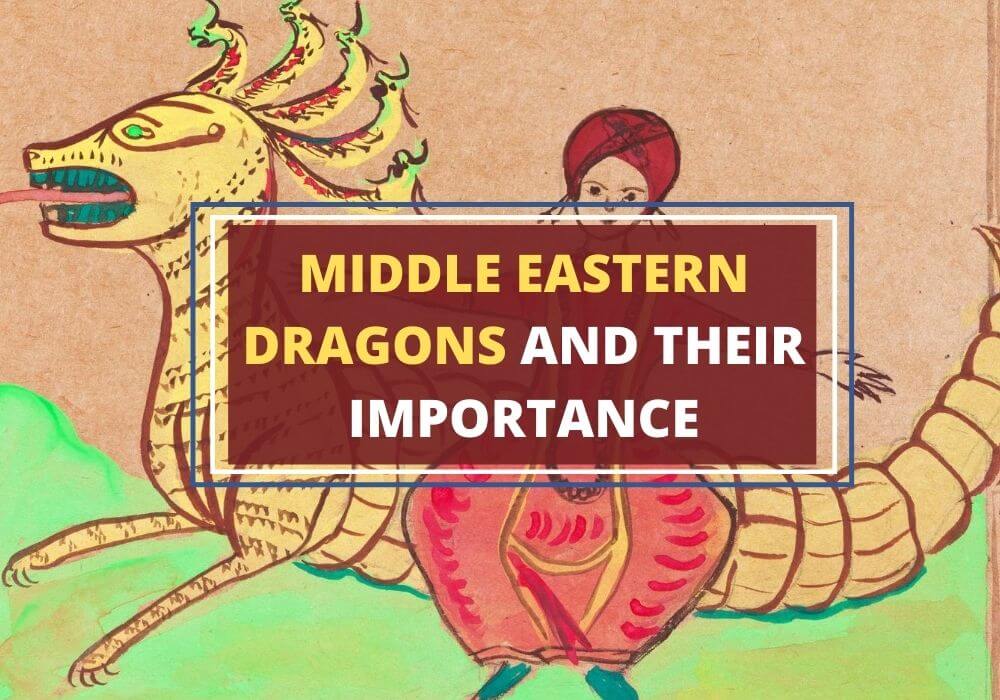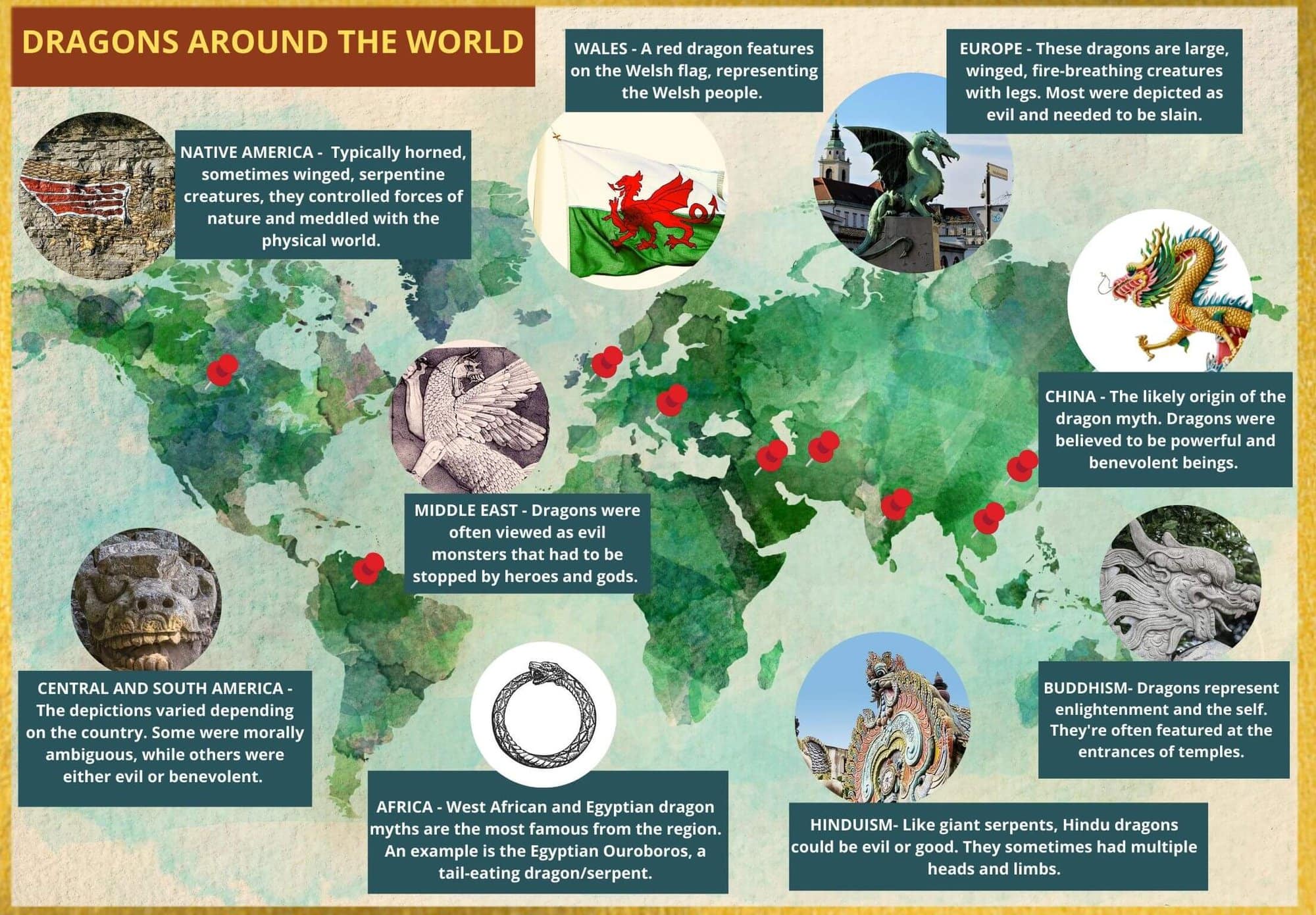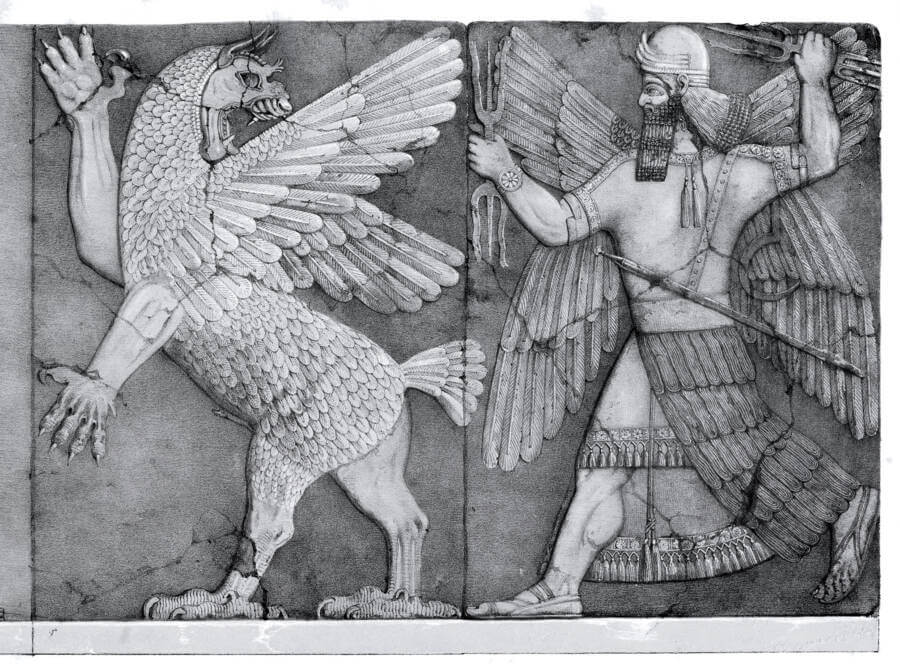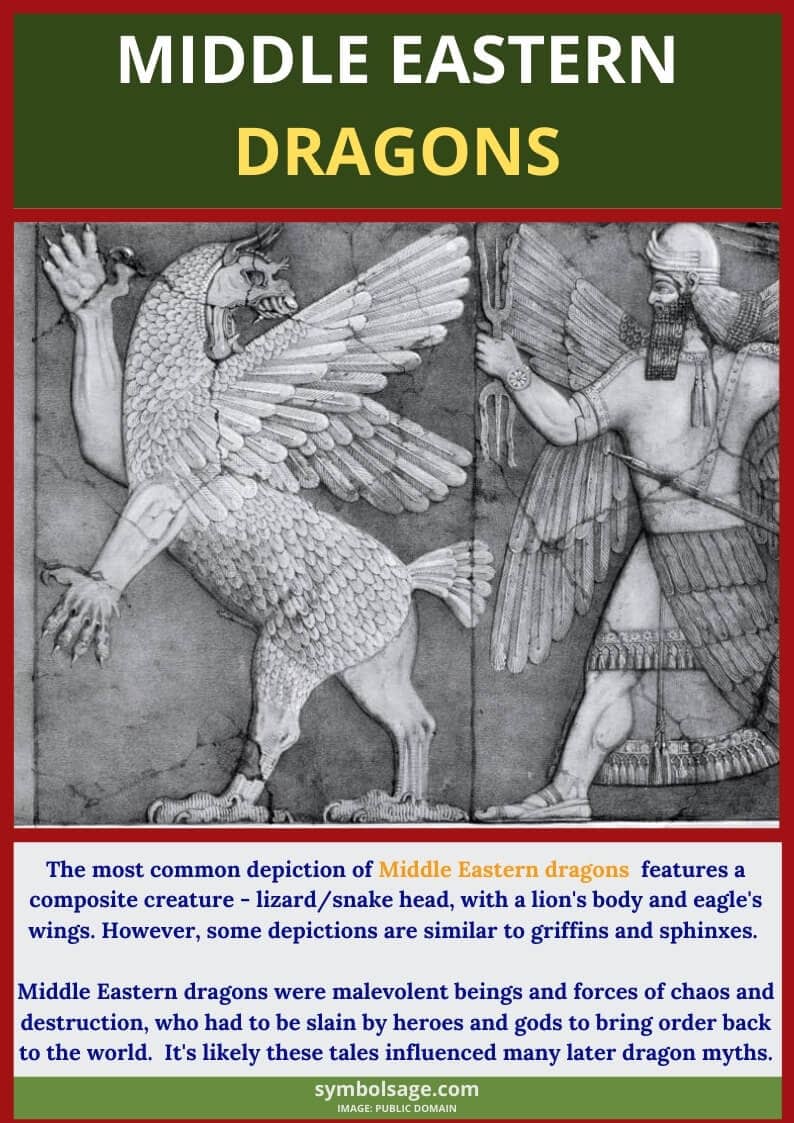
Table of Contents
The many dragons and serpentine monsters from the ancient Middle Eastern cultures are among the oldest in the world. Some of them can be traced back to over 5,000 thousand years ago which puts them in contention with Chinese dragon myths for the oldest dragon myths in the world.
Due to the emergence of the three Abrahamic religions from the region, however, dragon myths haven’t been very common in the Middle East in the past couple of thousand years and haven’t seen as much development as those of other cultures. Nevertheless, Middle Eastern dragon myths are still very rich and diverse.
In this article, we’ll take a closer look at Middle Eastern dragons, how they were depicted and what role they played in the myths of the region.

Middle Eastern Dragons’ Appearance
The dragons among most of the ancient Middle Eastern cultures were quite extravagant and diverse. Many of them had plain serpent-like bodies but in giant sizes, while others exhibited very chimera-like characteristics.
Many of the Persian, Babylonian, Assyrian and Sumerian dragons had the bodies of lions with snake heads and tails and eagle wings, while others had human heads similar to the Egyptian and Greek sphinxes. Some were even depicted with eagle heads similar to griffins. There were even dragons with scorpion tails. In general, many of the named mythological dragons used to be depicted with different bodies and physiques depending on the style of the artist that created the depiction.
Nevertheless, the most common depiction aside from the standard serpent-like body was that of a lizard or snake head and tail on a lion’s body with eagle wings.
What Did Middle Eastern Dragons Symbolize?
As far as what they represented, most Middle Eastern dragons and serpents were considered malevolent. They ranged from trickster spirits and semi-divine monsters, through evil gods, all the way to cosmic forces of chaos and destruction.
This makes them very different from the East Asian dragon myths in which these beings are often benevolent, wise, and worshipped by the people. It’s believed that, together with the Hindu Vritra myth, the Middle Eastern dragon myths were the predecessors of the modern European dragon myths where these creatures are also viewed as evil and monstrous.
Apsu, Tiamat and Babylonian Dragons

Apsu and Tiamat are the two ancient dragons in the Babylonian religion which are at the center of the Babylonian creation myths.
- Apsu was the universal primeval father, a serpent god of fresh water. He was depicted as wise and knowledgable, and a bringer of happiness and abundance across the land, making him one of the few benevolent dragons in the Middle Eastern mythologies.
- Tiamat, on the other hand, was Apsu’s counterpart. She was the dragon goddess of salt waters, and was fierce, turbulent, chaotic, and raw, and was feared by the people. Together with Apsu, Tiamat gave rise to all the other gods and goddesses of ancient Babylon, including Marduk – the main deity in Babylonian mythology.
Similar to the Titan myth in Greek mythology, here too the Babylonian gods clashed with their Dragon predecessors. According to the myths, Apsu was the one who grew troubled and annoyed by the clamor of the young gods and started plotting against them despite his wisdom. And even though Tiamat was the one who was fiercer of the two dragon deities, she initially didn’t want to join Apsu in his plotting against the gods. However, when the god Ea struck Apsu down, Tiamat grew angry and attacked the gods, looking for revenge.
It was Marduk who eventually slew Tiamat and brought on the age of the gods’ dominance over the world. Their battle is most famously depicted by the above image, even though in it Tiamat is portrayed as a griffin-like monster and not a dragon. In most other depictions and descriptions of the ancient goddess, however, she’s shown as a giant serpent-like dragon.
From this creation myth, many other smaller but still powerful dragons and serpents “plague” the people, heroes, and gods in Babylonian mythology. Marduk himself was often portrayed with a smaller dragon by his side as after his victory over Tiamat he was viewed as a master of dragons.
Sumerian Dragons
In Sumerian mythology, dragons served a similar role to those in Babylonian myths. They were terrifying monsters that tormented the people and heroes of present-day Southern Iraq. Zu was one of the more famous Sumerian dragons, also known as Anzu or Asag. Zu was an evil dragon god, sometimes depicted as a demonic storm or tempest bird.
Zu’s biggest feat was stealing the Tablets of Destiny and Law from the great Sumerian god Enlil. Zu flew with the tablets to his mountain and hid them from the gods, thus bringing chaos to the world as these tablets were meant to bring order to the universe. Later, the god Marduk, similar to his Babylonian counterpart, slew Zu and retrieved the tablets, bringing order back to the world. In other versions of the Sumerian myth, Zu was defeated not by Marduk but by Ninurta, Enlil’s son.
Other lesser Sumerian dragons followed the same template – evil spirits and semi-deities that sought to bring chaos to the world. Kur is another famous example as he was a dragon-like monster associated with the Sumerian hell which was also called Kur.
Other famous Sumerian, Babylonian, and Middle Eastern dragons include the Zoroastrian Dahaka, the Sumerian Gandareva, the Persian Ganj, and many others.
Inspirations of Biblical Dragon Myths
As all three of the Abrahamic religions were established in the Middle East, it’s not surprising that many of the myths and subjects of these religions were taken from ancient Babylonian, Sumerian, Persian, and other Middle Eastern cultures. The story of Zu’s Tablets of Destiny and Law is a good example but there are also many actual dragons in both the Bible and the Quran.
Bahamut and Leviathan are two of the most famous dragons in the Old Testament. They aren’t thoroughly described there but are explicitly mentioned. In most Middle Eastern myths, both Bahamut and Leviathan were giant winged cosmic sea serpents.
The overall disdain for serpents and reptiles in the Bible and the Quran is also believed to have come from the Middle Eastern dragon myths.

In Brief
Dragons can be found in every major culture, and appeared in the myths and legends around the globe. Of these, the Middle Eastern dragons remain among the world’s oldest, if not the oldest. These dragons were fearsome, ruthless beings of large size and strength, with crucial roles to play in the creation and equilibrium of the universe. It’s possible that many of the later dragon myths sprang from the stories of the Middle Eastern dragons.








